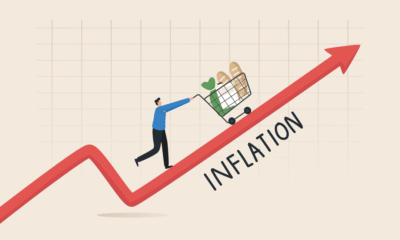Finance & Education
The Burden of Student Loans: Why Millennials are Struggling Again

Introduction to the Student Loan Crisis
The student loan crisis in America has reached perilous proportions, significantly impacting millennials whose financial stability is already fragile. Over the years, the cost of higher education has seen an alarming increase, with tuition rates consistently outpacing inflation and wage growth. This financial burden is not merely a statistic; it represents the lived experience of millions who now find themselves grappling with insurmountable debt levels that can affect their economic choices for decades.
Historically, student loans were introduced as a means to promote access to education. Initially framed as a tool for socioeconomic mobility, they have evolved into a considerable financial encumbrance. The federal government and educational institutions have, over time, contributed to the escalation of tuition fees, often without a commensurate increase in funding or financial aid options for students. The result has been an escalating cycle where students must borrow more to cover exorbitant costs, leading to unprecedented levels of student debt. As of 2023, reports indicate that student loan debt in the United States has surpassed $1.7 trillion, with millennials carrying a significant portion of this burden.
This financial strain can lead to a series of long-term repercussions, including delayed home ownership, lower rates of savings, and difficulty in pursuing further educational opportunities. Millennials—many of whom entered the workforce during the Great Recession—have been particularly affected by a combination of stagnant wages and high unemployment rates, exacerbating their vulnerability to student loan debt. Compounded by rising costs of living, the financial stakes for this generation are higher than ever. The ensuing student loan crisis not only jeopardizes individual futures but also poses broader implications for the economy, as the burden of debt stunts consumption and investment amongst a significant demographic of potential consumers.
Millennials and the Rise of Student Debt
Millennials, often defined as individuals born between 1981 and 1996, are facing unprecedented levels of student debt, the implications of which resonate deeply across various aspects of their financial and personal lives. As of 2023, the total student loan debt in the United States surpassed $1.7 trillion, with millennials accounting for a significant portion of this burden. On average, millennials hold approximately $30,000 in student loans, a figure that can vary based on education level, type of institution attended, and the zip code where they reside. This heavy financial obligation has substantial ramifications on the ability of this generation to achieve key life milestones.
The impact of student loans on millennials extends well beyond immediate financial strain. With such considerable monthly payments, many millennials find it challenging to save for essential goals, such as home ownership. According to recent studies, nearly 40% of millennials cite student debt as a barrier to purchasing their first home, contributing to an ongoing rental crisis and stagnation in the housing market. Furthermore, the average age of first-time homebuyers in this demographic has risen in recent years, showcasing a shift tied directly to the financial constraints imposed by student loans.
In addition to housing challenges, the burden of student debt adversely affects millennials’ ability to save for retirement. Many young adults, weighed down by loan payments, choose to postpone contributions to retirement accounts, leading to concerns about their long-term financial security. Consequently, the deferred financial decision-making not only limits immediate opportunities but also poses risks for approaching financial independence.
Overall, the rising tide of student debt among millennials is more than a statistic; it is a defining element of this generation’s economic experience. These burdens shape their priorities and decisions, ultimately influencing the broader economy. A comprehensive approach to addressing student debt is therefore essential for enabling millennials to thrive in an increasingly complex financial landscape.
The End of Loan Forgiveness Programs
The landscape of student loan forgiveness programs has undergone significant changes in recent years, impacting millennials who depend on these initiatives to manage their mounting debt. Originally designed to alleviate financial burdens, these programs have become increasingly difficult to navigate due to legislative adjustments and financial restrictions. For many young adults, the expectation of loan forgiveness served as a beacon of hope, inspiring a degree of optimism amid the staggering statistics regarding student loan debt in the U.S.
As government policies have evolved, numerous programs intended for easing repayment obligations have seen more stringent eligibility requirements. Initiatives like Public Service Loan Forgiveness (PSLF) became particularly iconic in this regard. While the program was designed to forgive federal loans for public service workers after 120 qualifying payments, challenges emerge with the insistence on strict eligibility criteria and documentation processes that are often complex and confusing. As a result, millennials striving for financial freedom have faced disappointment, as many find themselves ineligible after years of repayment.
Moreover, the political climate surrounding education financing and loan forgiveness has introduced uncertainty, leading to a lack of essential funding and resources that could have sustained these programs. Consequently, borrowers have noted hesitancy from financial agencies to advance policies that would facilitate loan forgiveness, exacerbating the already considerable anxiety surrounding student debt. This withdrawal of support can lead to feelings of disenfranchisement among millennials, who perceive themselves as having been misled regarding their ability to secure forgiveness for their student loans.
Ultimately, the shift in the commitment to loan forgiveness initiatives has stirred apprehension among young borrowers. With many millennials still grappling with substantial student loan debt, the end of these supportive programs has implications not only for their personal financial stability but also for the broader economic landscape, as they may delay major life decisions such as homeownership or starting a family.
The Impact of Interest Rates
The burden of student loans has become increasingly apparent among millennials, particularly in light of rising interest rates. This phenomenon serves to exacerbate an already challenging financial landscape for many recent graduates. When interest rates increase, the cost of borrowing money also escalates, leading to higher overall loan amounts that borrowers must contend with. As a result, those with student loans frequently face inflated monthly payments that can stretch their financial resources thin.
In essence, higher interest rates transform the repayment process into a significantly more burdensome endeavor. For millennials, the implications may include a longer repayment schedule, which can further complicate their financial planning and limit their ability to achieve other life goals, such as home ownership or saving for retirement. When borrowers are committed to extended repayment terms due to high interest rates, it often leads to a cycle of debt that is challenging to escape. Given the already high cost of living and stagnant wages in many sectors, this situation can exacerbate the difficulties millennials face in managing their finances.
Moreover, the unpredictability of interest rates complicates financial decision-making for many young adults. Those who secured loans at lower rates might find themselves at a disadvantage if they need to refinance or seek additional funding for further education. The constant fluctuation can create an atmosphere of uncertainty, making it difficult for millennials to budget accurately and plan for their futures effectively. In light of these challenges, rising interest rates play a pivotal role in increasing the financial strain associated with student loans, disproportionately affecting millennials who are already grappling with various economic pressures.
Employment Trends and Wages for Millennials
The employment landscape for millennials has undergone significant shifts, particularly in the wake of the financial crises and evolving market demands. A combination of stagnant wages and job market volatility has exerted a substantial burden on this generation, making it increasingly challenging to manage and repay student loans. In recent years, millennials have experienced a unique set of obstacles that have shaped their professional journeys, creating a complex environment for financial stability.
One of the most notable trends impacting millennials is the stagnation of wages. Despite increases in the cost of living, median wage growth has remained relatively flat, failing to keep pace with inflation. This stagnation places millennials at a distinct disadvantage, as they find their purchasing power eroded, ultimately consuming a larger portion of their income just to cover basic living expenses. Consequently, with fixed incomes and rising costs, the ability to allocate funds towards the repayment of student loans diminishes, resulting in prolonged debt cycles.
Additionally, millennials have had to navigate a job market characterized by volatility and a lack of job security. Following the 2008 financial crisis, many entry-level positions became scarce, leading to fierce competition for available roles. Industries such as technology and healthcare have seen growth, yet many millennials remain in part-time or lower-paying jobs that do not align with their skill sets or educational backgrounds. This mismatch perpetuates underemployment, further complicating their financial situations and inhibiting their capacity to manage educational debts effectively.
Moreover, trends such as the gig economy have emerged, providing some flexibility but often lacking the stability and benefits associated with full-time employment. As a result, millennials frequently juggle multiple jobs in an attempt to increase their earnings, yet this often comes at the cost of job satisfaction and a work-life balance. As the employment landscape continues to evolve, it is essential to understand how these factors combine to impact millennials’ ability to repay their student loans, amidst a backdrop of economic uncertainty.
Mental Health Effects of Student Loan Debt
The burden of student loan debt has far-reaching implications that extend beyond financial statistics, significantly impacting the mental health and overall well-being of millennials. As individuals face increasing pressures to manage hefty debts, a growing body of research indicates that the psychological toll can be profound. Anxiety, depression, and elevated stress levels are commonly reported among those grappling with student loans, creating a complex interplay between financial concerns and mental health issues.
Various studies underscore the connection between financial strain and mental health challenges. Research published in journals such as the “Journal of Adolescent Health” reveals that young adults with substantial student debt experience higher rates of anxiety and depression compared to their debt-free counterparts. The incessant worry about meeting payment deadlines, accumulating interest, and the fear of default can be overwhelming, contributing to heightened feelings of hopelessness and persistent stress.
Personal narratives further elucidate the emotional impact of student loan debt. Many millennials express feelings of isolation and intense pressure, stemming from societal expectations to achieve financial independence while simultaneously managing their loan repayments. The stigma associated with accumulating debt can deter individuals from seeking support, often exacerbating mental health issues. These narratives highlight how student loans can create a vicious cycle, where mental health challenges impede individuals’ ability to secure stable employment or pursue career advancement, ultimately perpetuating financial instability.
Moreover, the effects of student debt on mental health are not limited to immediate feelings of anxiety or sadness. Long-term implications include chronic stress, which can lead to physical health issues, relationship strain, and decreased life satisfaction. The distress caused by managing student loans can overshadow personal achievements, ultimately influencing individuals’ quality of life.
Policy Recommendations for Relief
The substantial burden of student loans on millennials has necessitated a reevaluation of existing policies and potential avenues for relief. By identifying strategic policy changes, it is possible to mitigate the adverse effects of student debt and foster a more supportive educational environment. One primary recommendation is to restructure loan forgiveness programs. Current initiatives often fail to reach those most in need due to strict eligibility criteria. By expanding these programs and allowing broader access, particularly for those working in public service and essential industries, borrowers could significantly reduce their loan balances through targeted relief.
Additionally, altering repayment plans could alleviate financial strain on millennials. Presently, many repayment options do not adequately reflect the income trajectories of recent graduates, who frequently encounter stagnant wages amid rising living costs. Implementing income-driven repayment plans that more accurately consider economic conditions would allow borrowers to repay loans more sustainably. Such a method would adapt payments according to income fluctuations, ultimately preventing defaults and loan delinquencies.
Advocating for more accessible education funding options plays a critical role in this discourse. Increasing state-level investments in higher education as well as providing grant funding rather than loans can create pathways for prospective students to pursue their academic goals without the looming threat of debt. Additionally, enhancing financial literacy programs at the high school level can better prepare individuals for the realities of student loans, ensuring informed decisions regarding their education financing.
Through the implementation of these policy recommendations, the burden of student loans can be alleviated for millennials. It is essential for stakeholders at various levels, from policymakers to educational institutions, to actively engage in establishing a more equitable student loan system that prioritizes the financial well-being of borrowers.
Personal Financial Strategies for Managing Debt
Managing student loans effectively is a critical challenge for many millennials. As the burden of student debt continues to escalate, establishing a robust personal financial strategy becomes paramount. A practical approach to budgeting serves as the cornerstone for financial management. By creating a clear budget, individuals can prioritize essential expenses, including their loan payments, while also identifying areas where they can reduce discretionary spending.
One effective strategy for managing student loans is loan consolidation. This process combines multiple loans into a single loan, simplifying the repayment process and often leading to lower monthly payments. Moreover, this option can be beneficial as it enables borrowers to secure a fixed interest rate, thereby mitigating the risks associated with fluctuating rates. Furthermore, individuals should explore income-driven repayment plans, which adjust monthly payments according to one’s income and family size; this can significantly lessen financial strain.
Additionally, establishing an emergency fund while managing student loans is vital. Even saving a small amount each month can create a financial cushion that enables borrowers to handle unexpected expenses without derailing their loan repayment strategy. Using automatic transfers to a separate savings account can assist in not only building this fund but also fostering strong saving habits.
Finally, seeking financial counseling or assistance from qualified professionals can provide tailored guidance. A financial advisor can evaluate one’s unique situation, offering personalized strategies to manage debt while planning for future financial goals. By proactively engaging in these strategies, millennials can navigate their student loans more effectively, ultimately regaining control over their personal finances and paving the way for a more secure financial future.
Conclusion: A Call to Action
The issue of student loans has increasingly become a significant burden for millennials. With the skyrocketing cost of higher education, many young adults are left grappling with overwhelming debt that can influence their financial stability for years to come. This blog post has discussed the various challenges faced by this generation, including the impact of student loans on career choices, mental health, and life milestones such as homeownership and family planning. The statistics are alarming, indicating that millions of millennials are trapped in a cycle of debt that hinders their economic freedom and growth.
It is imperative that all relevant stakeholders—government bodies, educational institutions, and financial organizations—step up to address this crisis. Policymakers must consider implementing comprehensive reforms that will alleviate the financial strain of student loans. Solutions such as income-driven repayment plans, loan forgiveness programs, and adjustments to interest rates could provide much-needed relief for struggling borrowers. Additionally, educational institutions should reevaluate their tuition pricing and explore alternative funding options to minimize the financial burden on students.
Moreover, financial organizations have a role to play in restructuring existing loans and offering better terms that prioritize the well-being of borrowers. Only through concerted efforts can we begin to mitigate the heavy toll that student loans have taken on millennials and their future. As we reflect on the urgency of this student loan crisis, it is clear that immediate action is not merely advisable, but necessary. The time for change is now, and we must work collectively to create a more sustainable and equitable path forward for future generations.

Finance & Investment
Trade Surveillance in Banking: Lessons from JPMorgan’s $348 Million Fine

Trade surveillance is a critical compliance function in banking and financial services that ensures the integrity of market activities and adherence to regulatory requirements. Effective trade monitoring helps prevent market abuses such as insider trading, front-running, and manipulation, protecting both investors and the broader financial system. Recently, JPMorgan Chase faced a substantial $348 million fine imposed by the Federal Reserve and the Office of the Comptroller of the Currency (OCC) due to inadequate trade surveillance controls. This high-profile penalty serves as a stark reminder to banks worldwide about the vital need for robust monitoring systems. Trade surveillance involves collecting and analyzing massive volumes of trading data in real time to identify suspicious behaviors or patterns that may indicate misconduct. As markets become more complex and trading volumes grow exponentially, financial institutions must invest heavily in surveillance technologies and governance frameworks to meet evolving regulatory expectations and safeguard their reputations.
The JPMorgan Case: What Went Wrong?
JPMorgan Chase’s penalty arose from several shortcomings in its trade surveillance program. Regulators found that the bank’s monitoring systems failed to adequately cover all trading venues and did not effectively analyze the full range of data needed to detect potential misconduct. Gaps in oversight allowed certain trading activities to go unchecked, increasing the risk of market abuses. Additionally, the bank’s controls were insufficient in preventing or identifying misconduct promptly, which is crucial for timely investigation and remediation. These deficiencies pointed to weaknesses in both technology infrastructure and internal governance. The case highlighted the consequences of inadequate surveillance, not only in terms of financial penalties but also reputational damage and potential loss of client trust. For financial institutions, the lesson is clear: trade surveillance cannot be an afterthought but must be a comprehensive, continuously updated program integral to daily operations.
Best Practices for Effective Trade Surveillance Systems
To avoid costly penalties and operational risks, banks need to implement trade surveillance systems that are robust, scalable, and adaptive. Best practices include integrating advanced analytics capable of processing large data sets across multiple trading platforms in real time. Machine learning and artificial intelligence technologies are increasingly being used to improve anomaly detection, reduce false positives, and provide compliance teams with actionable insights. Comprehensive surveillance programs also require strong governance frameworks that ensure clear roles, responsibilities, and accountability within the institution. Regular audits and continuous improvement cycles help identify gaps and adapt to new market practices or regulatory changes. Employee training and cultivating a compliance-oriented culture are equally important to ensure that staff understand surveillance requirements and actively support adherence. Transparency in reporting and effective communication with regulators can further enhance a bank’s ability to manage compliance risks proactively.
Technology’s Role in Enhancing Trade Surveillance
The complexity of modern financial markets demands that trade surveillance leverages cutting-edge technology solutions. Automated systems can monitor millions of trades, cross-referencing data from various sources such as order books, messaging systems, and market data feeds. AI-powered algorithms identify suspicious patterns that human monitors might miss and prioritize alerts for compliance teams to investigate. These technologies not only improve detection speed but also help reduce the burden of manual reviews, allowing staff to focus on high-risk cases. Additionally, cloud computing and big data architectures enable scalable storage and processing power essential for handling the volume and velocity of trade data. Implementing these technological advancements positions banks to meet stringent regulatory standards while maintaining operational efficiency and competitive advantage.
Strategic Takeaways for Banks and Financial Institutions
The JPMorgan fine underscores that trade surveillance is a critical area where banks cannot afford complacency. Financial institutions must treat compliance as a strategic priority, allocating sufficient resources to technology, people, and processes. Proactive investment in surveillance infrastructure not only reduces the risk of regulatory penalties but also enhances trust among clients and investors. Moreover, comprehensive trade monitoring helps detect internal control weaknesses and potential operational risks early, preventing larger issues. Institutions should conduct regular risk assessments to identify vulnerabilities and tailor surveillance parameters accordingly. Collaboration with regulators and industry groups can provide insights into emerging threats and best practices. Ultimately, integrating trade surveillance into the core of banking operations fosters a culture of integrity and resilience that benefits the institution and the financial markets as a whole.
Conclusion: Compliance as a Competitive Advantage
In conclusion, the JPMorgan Chase $348 million fine serves as a powerful cautionary tale for the banking sector, emphasizing the critical importance of effective trade surveillance. As financial markets evolve and regulatory scrutiny intensifies, banks must invest in sophisticated monitoring systems supported by advanced analytics and a strong compliance culture. Trade surveillance is not merely a regulatory obligation but a strategic tool that protects market integrity, strengthens client relationships, and mitigates operational risks. By learning from high-profile cases like JPMorgan’s, financial institutions can enhance their surveillance capabilities, avoid costly fines, and maintain their competitive edge in a complex and rapidly changing industry landscape. For banks committed to excellence, compliance and innovation must go hand in hand to build sustainable, trustworthy financial services for the future.
Economics
Asia’s Private Credit Boom: What It Means for Retail Investors

The Asia Pacific region is witnessing an extraordinary surge in private credit, transforming the financial landscape significantly. Private credit refers to direct lending to companies outside public markets, and over the last decade, this sector’s assets under management have grown from around $500 million to nearly $2 trillion. This rapid expansion is largely driven by emerging markets such as India and Australia, where businesses increasingly seek alternative financing solutions beyond traditional bank loans and public debt offerings. Historically, private credit has been dominated by institutional investors including pension funds and private equity firms. However, the landscape is evolving as retail investors gain access to this asset class through changing regulations, fintech platforms, and increased market demand. The expanding private credit market now offers retail investors an opportunity to diversify their portfolios and participate in an asset class that has demonstrated strong returns and resilience.
Why Private Credit Appeals to Retail Investors
Private credit has grown in popularity due to its potential to offer higher returns compared to traditional fixed-income investments such as government bonds or corporate debt. This is because private credit involves lending to companies with less liquidity and higher credit risk, factors that typically command a premium in yields. Retail investors often face challenges like low interest rates on savings and volatile stock markets, making private credit an attractive alternative for income generation and diversification. The growing involvement of financial giants such as JPMorgan Chase, which has recently allocated over $50 billion into the Asia Pacific private credit market, highlights the confidence that institutional investors have in the asset class. This institutional interest helps validate the opportunity for retail investors to explore private credit as part of a balanced investment strategy that supports both income goals and risk mitigation.
Regional Drivers Behind Asia’s Private Credit Boom
Asia’s private credit growth is closely tied to specific market conditions and regulatory environments within the region. In India, the tightening of banking regulations and a rise in non-performing assets have created a financing gap that private credit funds are actively filling. This has allowed companies to access capital through more flexible and tailored lending arrangements. Meanwhile, Australia’s advanced financial system and regulatory framework support a vibrant ecosystem of private credit funds and alternative lending platforms. These developments offer retail investors in these markets a variety of ways to participate in private credit. Investors can access this asset class through private debt mutual funds, alternative asset management platforms, and regulated digital lending marketplaces. Nevertheless, understanding the regulatory landscape and investment vehicle structures is critical to ensuring compliance and aligning investments with personal risk tolerance.
Key Risks and Considerations for Retail Investors
While private credit offers appealing opportunities, it is important for retail investors to be aware of its unique risks and challenges. Unlike publicly traded securities, private credit investments often involve longer lock-in periods during which liquidity is limited. This means investors may not be able to access their funds quickly, which could be a disadvantage for those requiring flexible cash flow. Additionally, private credit carries credit risk, meaning the possibility of borrower default can impact returns. Transparency is typically lower in private credit compared to public markets, so investors should diligently assess the quality and track record of the fund managers or platforms offering these investments. Understanding the underlying borrower profiles and loan terms is essential to mitigate potential losses. Fees can also be higher due to the complexity involved in underwriting and managing private loans. For these reasons, retail investors should perform comprehensive due diligence, seek professional advice, and only allocate a suitable portion of their portfolios to private credit.
The Role of Education and Professional Guidance
Given the complexities of private credit investing, education and expert advice are indispensable for retail investors. Keeping abreast of regulatory changes, market trends, and emerging opportunities is vital to making informed decisions. Awareness of how alternative investments are regulated in different countries within Asia Pacific helps avoid compliance issues and ensures access to legitimate investment products. Many financial advisors recommend that retail investors allocate a moderate portion of their investment portfolios to private credit as a way to enhance income and reduce correlation with traditional asset classes. However, this allocation should reflect an investor’s financial goals, risk appetite, and liquidity needs. Partnering with experienced fund managers or licensed investment platforms can provide additional safeguards and insights into this relatively complex market.
Supporting Regional Economic Growth Through Investment
Investing in private credit is not only about financial returns; it also plays an important role in supporting economic growth in Asia Pacific. Private credit financing helps small and medium enterprises (SMEs), startups, and infrastructure projects secure the capital they need to expand operations, innovate, and create jobs. Retail investors who participate in this market contribute indirectly to these positive economic outcomes, fostering development and entrepreneurship across the region. This dual benefit of combining financial gains with social impact adds an appealing dimension to private credit investment. It allows investors to align their portfolios with broader economic progress and community development goals, enhancing the meaning and satisfaction derived from their investments.
Conclusion: Unlocking Opportunities in Asia’s Private Credit Market
In summary, the Asia Pacific private credit boom offers an exciting and valuable opportunity for retail investors ready to explore alternative asset classes. The rapid market growth, strong institutional backing, and improving regulatory frameworks create a conducive environment for investment. However, retail investors must remain cautious and informed, understanding the risks related to liquidity, credit, and transparency. A well-researched and diversified approach, combined with professional guidance, can help investors unlock the benefits of private credit while managing potential downsides. As private credit continues to mature and gain accessibility, it is expected to become a vital part of diversified investment portfolios, offering both attractive financial returns and meaningful economic impact across the region.
Investing
Global Investor Outflows from U.S. Stocks & Dollar

In a shift that is sending ripples across financial markets, institutional investors around the world are pulling back from U.S. equities and reducing exposure to the U.S. dollar, signaling a significant change in sentiment toward American assets. According to the latest Bank of America Global Fund Manager Survey, global investors are now the most underweight on U.S. stocks in more than two decades, with the dollar facing similar skepticism as a long-term safe-haven asset. This transition is being fueled by multiple converging factors, including geopolitical instability, growing U.S. fiscal deficits, trade tensions, and an increasingly favorable investment climate in Europe and select emerging markets. For investors, economists, and policymakers alike, this trend represents a rebalancing of global capital flows that could reshape market dynamics in the months ahead.
Investor Sentiment Toward U.S. Markets Hits Multi-Year Lows
The Bank of America survey, considered a key barometer of global institutional sentiment, reveals that fund managers have turned heavily underweight on U.S. stocks and the dollar, preferring instead to rotate their portfolios into European and Asian equities. The survey showed that 36% of participants are now net underweight U.S. equities—the highest level since 2003. At the same time, positioning on the dollar turned net negative for the first time in over five years, with investors citing mounting fiscal concerns, valuation extremes, and weakening macroeconomic indicators.
The U.S. equity market, especially the tech-heavy NASDAQ, has experienced an extraordinary bull run over the last several years. But now, investors are questioning the sustainability of elevated valuations, particularly as economic growth slows, earnings forecasts are revised downward, and inflation remains persistently above target. Many portfolio managers believe the best returns may no longer be found in U.S. assets alone.
Rising U.S. Debt and Fiscal Deficits Raise Red Flags
A key driver of investor caution is the ballooning U.S. fiscal deficit. The Congressional Budget Office (CBO) projects that the U.S. federal deficit will reach over $1.8 trillion this year, driven by increased government spending, rising interest costs, and lower-than-expected tax revenues. The national debt is now projected to exceed 125% of GDP by 2030, raising serious questions about long-term fiscal sustainability.
Investors fear that soaring U.S. debt levels could lead to a loss of confidence in Treasury securities, pushing yields higher and triggering volatility in global credit markets. This concern is magnified by the growing political polarization in Washington, which has led to repeated debt ceiling standoffs and policy gridlock. As a result, some asset managers are choosing to diversify their bond portfolios with sovereign debt from countries like Germany, Canada, and Australia—nations viewed as having stronger fiscal discipline.
Geopolitical Tensions Erode Dollar Safe-Haven Appeal
The traditional role of the U.S. dollar as a global safe-haven currency is also being called into question. With the U.S. now embroiled in rising geopolitical conflicts, including its military engagement in the Middle East and an escalating trade war with China, the perception of the dollar as a “neutral” or stable currency is beginning to fade. Several countries, particularly in the Global South, have voiced frustration over the dominance of the dollar in international trade, and some have even accelerated efforts to settle trade in alternative currencies such as the euro, yuan, or local currency blocs.
In response, central banks in emerging markets are reducing their U.S. dollar reserves and increasing holdings in gold and non-dollar currencies. This trend, while gradual, is gaining momentum and contributing to the dollar’s underperformance against a basket of global currencies. The U.S. dollar index (DXY) has declined by nearly 6% year-to-date, reflecting both diminished investor confidence and a broader reconfiguration of reserve management strategies.
Attractive Valuations Abroad Drive Capital Outflows
While risks in the U.S. are mounting, attractive investment opportunities abroad are also contributing to the outflow of capital from American markets. European equities, particularly in sectors like green energy, luxury goods, and financial services, are seeing renewed interest thanks to relatively low valuations and improving macroeconomic stability. The recent ECB rate cuts and Eurobond discussions have added to optimism about the region’s fiscal and financial integration.
In Asia, countries like India, Indonesia, and Vietnam are emerging as new hotspots for foreign direct investment and equity inflows. These economies offer robust growth prospects, younger demographics, and increasingly tech-driven industries. Additionally, Japan’s bond market is seeing increased institutional buying, as long-term yields rise in response to the Bank of Japan’s policy changes.
This global diversification strategy is not just about seeking higher returns—it’s also about managing risk. Investors are increasingly looking to balance their portfolios geographically, reducing dependence on any single region and hedging against macroeconomic shocks that may be specific to the U.S.
Currency Hedging and Diversification as Defensive Strategies
In response to the dollar’s volatility, many fund managers are now engaging in currency hedging strategies to protect their portfolios. Currency ETFs, options, and forward contracts are being used to minimize the downside risk of a weakening dollar. At the same time, global investment funds are ramping up their exposure to non-dollar-denominated assets, including eurozone corporate bonds, emerging market debt, and local-currency sovereign issues.
Moreover, ESG and green bond markets in Europe and Asia are attracting capital due to their alignment with global sustainability goals. These instruments not only offer diversification but also align with broader institutional mandates on responsible investing.
Implications for U.S. Markets and Monetary Policy
The capital flight from U.S. assets could have significant implications for American markets. A persistent decline in foreign demand for U.S. Treasuries may force the Federal Reserve to intervene more frequently in the bond market to maintain liquidity and control yields. At the same time, a weaker dollar could contribute to imported inflation, complicating the Fed’s efforts to bring core inflation back within its target range.
On the equities side, if investor outflows persist, U.S. companies may face higher capital costs and declining valuations, particularly in sectors that rely heavily on foreign investment or exports. Domestic pension funds and institutional investors may need to fill the gap left by global investors, which could further alter asset allocation strategies and influence corporate financing decisions.
A New Era of Global Capital Rotation
The growing shift away from U.S. stocks and the dollar signals the beginning of a new era in global investing, one defined by diversification, geopolitical hedging, and currency rebalancing. While the U.S. remains a central player in global finance, the days of unquestioned dominance are beginning to fade, as investors embrace a more nuanced and distributed view of risk and opportunity.
For market participants, staying agile in this environment means tracking global fund flows, monitoring geopolitical developments, and reassessing the traditional U.S.-centric portfolio model. As capital continues to flow into European and Asian markets, the future of global finance is being rewritten—and those who adapt early may find themselves ahead of the curve.
-

 Finance & Investment6 months ago
Finance & Investment6 months agoEmerging Markets to Watch in 2025: Opportunities and Risks
-

 Technology and Finance8 months ago
Technology and Finance8 months agoThe Future of Quantum Computing in Financial Modeling and Trading
-

 Finance7 months ago
Finance7 months agoUSA Market Trends & Global Finance Insights
-
Finance7 months ago
Navigating Retirement in the Gig Economy: Challenges and Solutions
-

 Finance8 months ago
Finance8 months agoNavigating Personal Finance in the Age of Inflation and High Interest Rates
-

 Economics6 months ago
Economics6 months agoGlobal Markets React to U.S. GDP Contraction: A Comprehensive Analysis
-

 Investing & Finance8 months ago
Investing & Finance8 months agoFractional Investing: The Path to Wealth Democratization
-

 Finance7 months ago
Finance7 months agoTop 10 High-Yield Savings Accounts in the US (2025 Edition)



